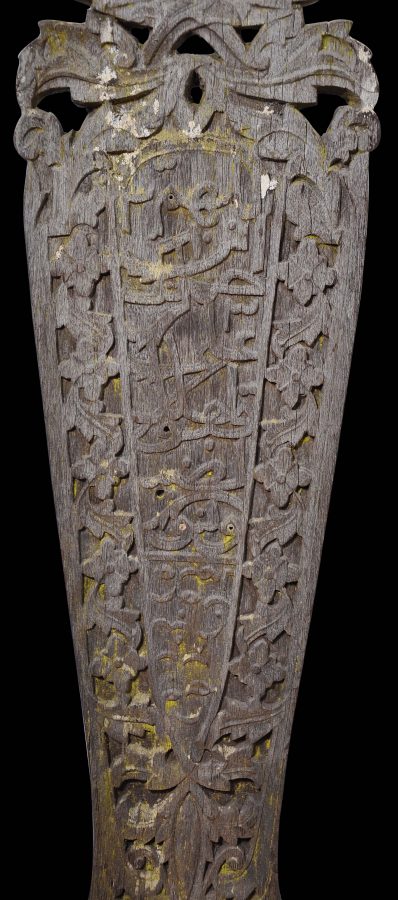This tall grave marker or funerary post is of single piece of carved iron wood. It is from the Malay Kutai people, a Malay sub-group who lived in the old Islamic Malay Sultanate of Kutai among the Mahakam River on Borneo island. Today, Borneo is shared by Indonesia, Malaysia and Brunei. The Kutai region is in the Indonesian part of the island.
The top panel of the marker has been carved with pierced and interlocking stylised orchid motifs very much in keeping with the Malay Islamic aesthetic. The central section of the panel has been carved with the local version of Arabic known asjawi. (Indeed, it is probably Kutai Malay, the local version of Malay.)
Both sides of the marker are carved in this manner, although the script differs on both sides.
Noor & Khoo (2003, p. 60) argue that the crown of the grave marker might represent unungan (a mountain top or even the pinnacle of Mount Meru) or pohon budi, the tree of life.
Typically, the taller the post, the higher the status of the deceased.
Similar grave posts with carved vegetal scrolling were used by Islamic Malay communities in the nearby Sulu Archipelago (now part of the Philippines) and on the Malay Peninsula. See Fernando-Amilbangsa (2005, p. 225-229) for Sulu examples, and Noor & Khoo (2003, p. 59-61) for Malay Peninsula examples, which feature the same interlocking foliage motifs as seen here.
The marker comes with a custom-made stand which allows the marker to stand upright and unaided in a stable fashion. As might be expected, there are minor losses to the extremities of the marker, wear from weathering and some marking from lichen having grown on the surface. Overall, it is a fine, sculptural item with a great presence. We have ascribed a conservative dating of early 20th century to the marker but it could be earlier.
References
Fernando-Amilbangsa, L., Visual Arts of the Sulu Archipelago, Ateneo de Manila University Press, 2005.
Noor, F. & E. Khoo, Spirit of Wood: The Art of Malay Woodcarving, Periplus, 2003.








